#nestor notabilis
Explore tagged Tumblr posts
Text























Кеа - горный попугай, который по умственным способностям превосходит обезьян.
Попугай Кеа (лат. Nestor notabilis)относится к роду Nestor семейству Strigopidae, однако он значительно отличается от других его представителей. По внешнему виду этот пернатый больше похож на ворона или сокола. Длина тела птицы достигает 46 см, а вес варьируется в пределах 0,6-1 кг, при этом самцы крупнее самок. Размах крыльев в полете достигает 1 м.В окрасе попугаев кеа преобладает оливково-зеленый цвет с серым отливом. А перья окантованы черным цветом, что создает впечатление чешуйчатости. Область под крыльями у кеа огненно-оранжевая, поэтому во время полета птицы кажется, что она охвачена пламенем. Голова бронзово-зеленая. Глаза у этих попугаев темно-коричневого оттенка с тонким глазным кольцом желтого цвета. Когти и клюв имеют более темный оттенок. А нижняя сторона тела коричневато-оливковая. Лапы у этих попугаев крепкие, мощные, серые. Они помогают пернатому держаться на любой поверхности и обеспечивают быстрое передвижение на ней. Клюв с удлиненной выгнутой верхней частью, что обеспечивает глубокое зацепление. Из-за его необычного строения кеа еще называют соколиным попугаем. У самки клюв меньшего размера, менее изогнут и значительно короче, чем у самца.
Попугаи кеа обитают сугубо в Новой Зеландии. Их можно встретить в лесах и долинах гор Южного острова на высоте от 600 до 2000 метров. Летом попугаи кеа обитают в кустарниках и альпийской тундре. Осенью перемещаются в более высокие районы, богатые ягодами. А зимой этих птиц можно встретить возле домиков туристов, горнолыжных курортов, кемпингов. Они настолько смогли приспособиться к суровым условиям, что с удовольствием купаются в лужах с ледяной водой, кувыркаются в снегу.
Кеа хоть и питается растениями, плодами и семенами, но при случае не отказывают себе и в животной пище. Это могут быть не только насекомые, мелкие грызуны, но и падаль. По свидетельству фермеров, кеа могут даже напасть на живых овец и довести их смерти, выклевывая подкожный жир у них на спине. Но такое происходит не так так часто и в основном в зимнее голодное время, когда птицам приходится выживать в весьма суровом горном климате.
Кеа не чураются общения с человеком. Они охотно вселяются поближе к человеческим жилищам и могут питаться пищевыми отходами, как бродячие собаки и кошки. Только, в отличие от них, кеа прекрасно могут вскрыть жестяные и пластиковые банки, мусорные баки и прочее. Мало того, они таким образом могут изуродовать автомобили, выдирая из них разные детали.Везде, где кеа обитают, стоят плакаты, призывающие не кормить попугаев. Но люди всё равно их кормят, превращая дикую птицу в попрошайку.Кеа могут нападать на группы туристов с целью найти и отнять что-то съестное. Рюкзаки, сумочки, зонтики, кошельки и другие подобные вещи – все интересует попугаев своей новизной и необычностью. В горах, недалеко от их местообитания, периодически находят «заначки» – спрятанные и различным образом отсортированные предметы.
Попугаи Кеа давно известны орнитологам своим уникальным умом. Птица легко обучается, с легкостью решает логические задачи, различает цвета и обладает отличной памятью. Обезьяны не смогли пройти все те испытания, которые с легкостью преодолели кеа. Также кеа способны обучаться, просто наблюдая за сородичем. Они хорошо работают как самостоятельно, так и в команде.
Kea is a mountain parrot that surpasses monkeys in intelligence.
The Kea parrot (lat. Nestor notabilis) belongs to the genus Nestor of the family Strigopidae, but it differs significantly from its other representatives. In appearance, this bird is more like a raven or a falcon. The body length of the bird reaches 46 cm, and the weight varies between 0.6-1 kg, with males larger than females. The wingspan in flight reaches 1 m. The color of kea parrots is predominantly olive-green with a gray tint. And the feathers are edged with black, which creates the impression of scaly. The area under the wings of the kea is fiery orange, so during the flight the bird seems to be engulfed in flames. The head is bronze-green. The eyes of these parrots are dark brown with a thin eye ring of yellow color. The claws and beak have a darker shade. And the underside of the body is brownish-olive. The paws of these parrots are strong, powerful, gray. They help the bird to stay on any surface and ensure fast movement on it. The beak has an elongated curved upper part, which provides a deep grip. Because of its unusual structure, the kea is also called a falcon parrot. The female's beak is smaller, less curved and significantly shorter than the male's.
Kea parrots live exclusively in New Zealand. They can be found in the forests and valleys of the mountains of the South Island at an altitude of 600 to 2000 meters. In the summer, kea parrots live in bushes and alpine tundra. In the fall, they move to higher areas rich in berries. And in winter, these birds can be found near tourist houses, ski resorts, campsites. They have adapted to the harsh conditions so well that they enjoy swimming in puddles of icy water and tumbling in the snow.
Although keas eat plants, fruits and seeds, they will also eat animal food if the opportunity arises. These can be not only insects, small rodents, but also carrion. According to farmers, keas can even attack live sheep and kill them by pecking out the subcutaneous fat on their backs. But this does not happen very often and mainly during the winter hungry season, when the birds have to survive in a very harsh mountain climate.
Keas do not shy away from communication with humans. They willingly settle closer to human dwellings and can feed on food waste, like stray dogs and cats. However, unlike them, keas can easily open tin and plastic cans, garbage cans, etc. Moreover, they can damage cars by tearing out various parts. Everywhere where kea live, there are posters calling not to feed the parrots. But people still feed them, turning the wild bird into a beggar. Kea can attack groups of tourists in order to find and take away something edible. Backpacks, handbags, umbrellas, wallets and other similar things - everything interests parrots because of their novelty and unusualness. In the mountains, not far from their habitat, "stashes" are periodically found - hidden and variously sorted objects.
Kea parrots have long been known to ornithologists for their unique intelligence. The bird is easy to learn, easily solves logical problems, distinguishes colors and has an excellent memory. Monkeys could not pass all the tests that kea easily overcame. Kea are also able to learn simply by observing their relatives. They work well both independently and in teams.
Источник://parrotologia.com/species/parrot-kea/,/dzen.ru/a / XlZe6sxX7yNJsynI, /dzen.ru/a/ZktjUgR6Im6eO1zM, /sharker. livejournal.com/128651.html, //pikabu.ru/story/kea__gornyiy _ popugay_kotoryiy_po_umstvennyim_sposobnostyam_prevoskhodit_obezyan_4425421, //4parrots.ru/5450-popugaj-kea/.
#New Zealand#nature#nature aesthetic#bird photography#Kea parrot#Nestor notabilis#ornithology#mountains#snow#rain#birds video#Новая Зеландия#природа#фотографии птиц#видео птиц#попугай#Кеа#орнитология#горы#снег#дождь#природнаякрасота
186 notes
·
View notes
Text
Kea (Nestor notabilis)
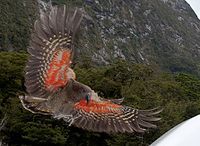
"Best parrot, possibly eats sheep"
"The kea nests in burrows or crevices among the roots of trees. Kea are known for their intelligence and curiosity, both vital to their survival in a harsh mountain environment. Kea can solve logical puzzles, such as pushing and pulling things in a certain order to get to food, and will work together to achieve a certain objective. They have been filmed preparing and using tools."
Typically touted as the world's only alpine parrot, the Kea hasn't always been confined to the mountain ranges it now calls home. They're now only found on the South Island of Aotearoa, but historically were found on the North Island as well. In both islands they used to be more common in lowland forests, but were pushed out due to humans and mammalian introduction.
The reports of kea eating sheep used to be highly contested, until August 1992 when an "attack" was captured on video. The kea were using their bill to rip through wool and eat the fat from the back of the sheep. This doesn't outright kill the sheep, but often then can become injured further while trying to escape the kea or can get infections from such a large wound. Since Kea are protected, the farmers simply have to deal with these attacks. They aren't frequent, however, and seem to be based more on individuals rather than an entire population of kea learning this behavior.
Source:
Image Source: wiki article
28 notes
·
View notes
Text
instagram
Nestor Kea, mon chouchou. Look at him all windswept-feathered !
0 notes
Text
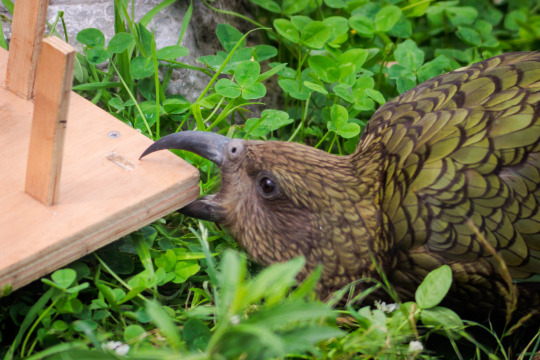
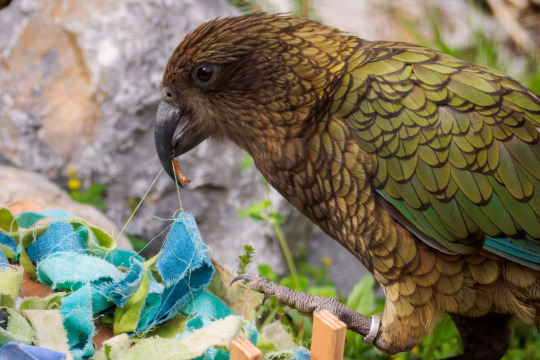
#Ziezoo#ziezoovolkel#Photography#Photo#Zoophotography#zoo#animal#animals#animalphotography#kea#Nestor#notabilis#birds
1 note
·
View note
Text

Kea (Nestor notabilis), family Strigopidae, order Psittaciformes, found on the South Island of New Zealand
ENDANGERED.
A few ornithologists place this genus in its own family, Nestoridae, but this has not been widely adopted.
photograph by Pavlina Trauskeova
904 notes
·
View notes
Note
Don't mind me, I was scrolling your blog and found the post about owl cafes, and now I'm too curious and horrified for my own good about a KEA being in a cafe? What was that about?
A couple of years back, a kea (Nestor notabilis) was found for sale in Japan in a bird cafe. We don't know how it got there. Like. We literally do not know how it is there. It's a pretty endangered bird--- beyond that, New Zealand has some of the strictest animal export laws in the world, right up there with Australia; hell, it only JUST lifted its export ban last year. The last kea export that I know of was in the late 90's and that was to a zoological facility in the States.
A cafe spokesman claims that the bird was imported from Europe, bred from animals obtained before the export ban in 1986. This... yeah, it's definitely possible, and is the only legal way the bird could be there. More than just the legal stuff, it's hard to imagine a single kea doing well in captivity.
These are amazingly social and demanding birds. All parrots need a substantial amount of social interaction, but kea are beyond even that. They've been filmed creating and using tools. Isolated individuals do badly even in professional zoos. I can't imagine a private home keeping one well. They also regularly take apart cars for fun, so again: not really a great animal to keep in a home.
110 notes
·
View notes
Text
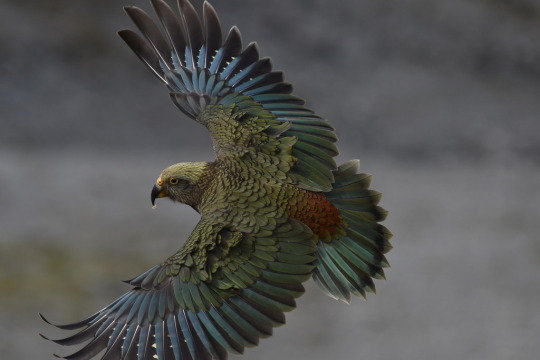
[https://www.inaturalist.org/observations/107591414]
Kea || Nestor notabilis
Observed in New Zealand
Endangered in location of observation
#ornithology#kea#birds#nature#wildlife#photography#air beast#earth beast#who cooks for queue? who cooks for queue all?
99 notes
·
View notes
Text




Kea Nestor notabilis
2/13/2023 Tracy Aviary, Utah
The kea at Tracy Aviary are very curious and personable! It's a really cool opportunity to get a close-up encounter with these endangered alpine parrots. These birds are a part of a Species Survival Plan between AZA-accredited facilities, and are being bred to preserve their species.
#kea#new zealand#parrot#parrots#captive animal#zoo animals#zoo#zoo photography#bird#birds#photography#photographers on tumblr#original photography#nature photography#tracy aviary#my photos#kestrel speaks
47 notes
·
View notes
Text

Kea ( Nestor notabilis)
Photo by @mikullashbee
The kea is a species of large parrot in the
family Nestoridae found in the forested and alpine regions of the South Island of New Zealand
62 notes
·
View notes
Text
#2700 - Nestor notabilis - Kea

A large, intelligent, omnivorous parrot endemic to the Southern Alps. Highly intelligent - they've been filmed making tools. Admittedly, the tools are then used to set off stoat traps, and apparently only because they find the loud bang funny. They presumably also find stealing small items, passports, wallets, and vandalising cars funny as well.
Kea nest in underground burrows.
They used to be found in lowland and coastal forests as well, but introduced predators and humans have driven them into the mountains. For many years there was a bounty paid for their destruction, because they attack sheep to eat the fat on their backs. Since 1970 they've been a protected species, but lead posoning from roofing nails is now a serious problem. There are now somewhere beween 3 and 7000 kea left in the wild.
Kiwi Park, Queenstown, Aotearoa New Zealand.
4 notes
·
View notes
Photo
Kea (Nestor notabilis)

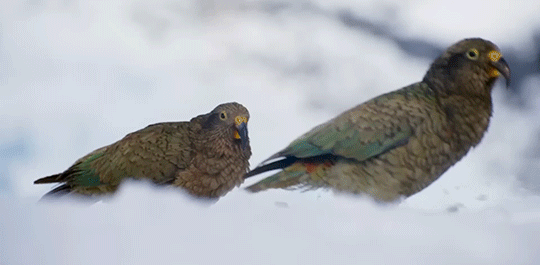


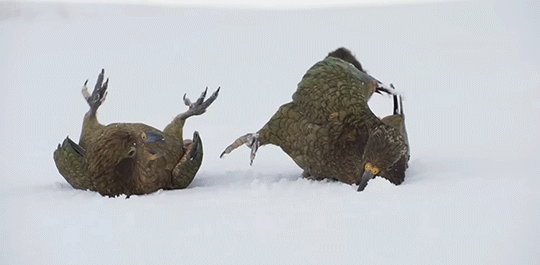
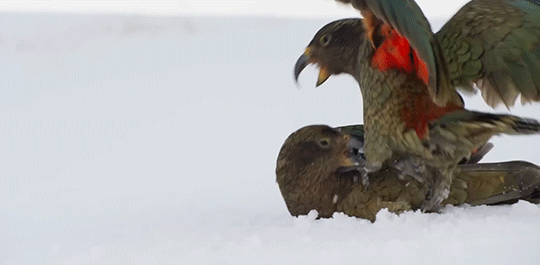

Playtime for young kea birds! There’s a benefit to this apparently carefree behavior. It helps establish long-lasting relationships between the youngsters and even diffuses tension. David Attenborough | BBC Earth
21K notes
·
View notes
Video
youtube
Helpful Tips for Learning About the Clever Kea Parrot: Fun Animal Facts, Conservation Tips, and More!
The Kea parrot is a captivating and intelligent bird found exclusively in New Zealand's rugged mountain regions. Famous for its playful nature, curiosity, and impressive problem-solving abilities, the Kea is a shining example of why Animal Education and Nature Education are crucial aspects of Animal Science. This article delves into intriguing Animal Facts, offers valuable Wildlife Tips, and provides essential Conservation Tips about this extraordinary parrot. Perfect for Animal Enthusiasts and those interested in Wild Wow Facts, these insights make learning about the Kea both informative and engaging.
What is the Kea Parrot?
The Kea (Nestor notabilis) is often affectionately called the “clown of the mountains” due to its adventurous and curious personality. Known for its olive-green feathers and striking flashes of orange under its wings, this parrot is visually stunning and behaviorally fascinating, drawing the attention of people interested in Animal Education and the vast Animal Kingdom. Here’s what makes the Kea unique:
Species Overview: The Kea is a large, alpine parrot native to New Zealand’s Southern Alps. It's one of the few parrot species adapted to cold mountain climates, thriving in high-altitude regions where temperatures can drop significantly.
Coloration and Appearance: Keas are olive-green with vibrant orange feathers under their wings, a trait that helps them stand out in their natural habitat. Their slightly curved beak aids in foraging and showcases their adaptability.
Endearing Personality: Known for their playful, inquisitive nature, Keas are social and often form small groups. This behavior makes them an excellent subject for Animal Behavior studies.
Why is the Kea Parrot So Special? Key Animal Facts and Behaviors
Keas are remarkable for their intelligence and adaptability, traits that make them favorites in both research and wildlife education. Here’s a closer look at the unique qualities that set this parrot apart and provide valuable insights for Animal Science and Nature Education.
Advanced Problem-Solving Abilities
Keas are known for their exceptional intelligence, often compared to primates for their advanced problem-solving skills. Researchers have observed these parrots solving puzzles and figuring out complex ways to access food. Here are some fascinating aspects of their intelligence:
Cognitive Abilities: Studies have shown Keas possess strong cognitive skills, often using tools and teamwork to solve challenges, highlighting them as excellent examples in Animal Science.
Curiosity and Innovation: Known for their curious nature, Keas can manipulate objects in their environment, whether they’re natural resources or man-made objects like backpacks or car antennas.
Learning Through Observation: Keas often watch each other to learn, a behavior that’s rare among birds and a key focus in Animal Education.
Playful and Mischievous Behavior
Known for being cheeky and mischievous, Keas have a playful side that sets them apart from most other birds. Their unique behavior patterns make them a fascinating subject in Animal Behavior studies:
Exploration and Interaction: Keas are always exploring their environment, often testing or dismantling objects out of sheer curiosity.
Community Bonding Through Play: In social groups, Keas play and interact, engaging in activities like sliding down snow-covered slopes or tossing objects, much like human children at play.
Impacts of Interaction with Humans: Due to their curious nature, Keas frequently interact with humans, especially in tourist areas. This behavior often leads to mischief, like unzipping bags or removing window seals.
Adaptable to Harsh Environments
Keas are highly adaptable birds that thrive in New Zealand’s mountainous regions, where temperatures can be unforgiving. Their ability to survive in these harsh environments provides rich material for Environmental Education:
Thick Feathers for Warmth: The Kea’s dense feathers help it endure colder temperatures in alpine environments, allowing it to live at altitudes where other birds might struggle.
Foraging Skills in Scarce Conditions: Keas adapt their foraging techniques to the season, relying on plants, seeds, insects, and occasionally scavenging for food, showcasing their dietary adaptability.
High-Level Adaptation for Survival: Keas have evolved behavioral and physiological adaptations to survive where resources are scarce and conditions are tough.
Kea Conservation: Wildlife Conservation and Animal Welfare Considerations
Keas are classified as an Endangered Species, and their continued survival faces challenges. Conservation efforts are essential for this unique parrot, and there are several key issues to consider for those invested in Animal Safety and Animal Welfare.
Threats from Predators
Introduced predators like stoats, cats, and rats pose a severe threat to the Kea population, which highlights the need for heightened Animal Safety and conservation measures. Here’s a closer look at the primary threats:
Impact of Predators: Stoats, rats, and other introduced predators attack Kea nests, preying on eggs and young birds, which significantly impacts population growth.
Efforts to Control Predators: Conservationists are working to limit predator populations in Kea habitats, using traps, barriers, and other methods to protect these vulnerable birds.
Human Interaction and Risk
Kea’s playful interactions with humans also bring potential risks. This is where Conservation Tips and public awareness play vital roles in ensuring the birds’ safety:
Attraction to Human Areas: Due to their curious nature, Keas are often drawn to populated areas, like parking lots and tourist spots, where they might get into dangerous situations.
Educational Campaigns: Conservation programs educate visitors on how to interact safely with Keas, including guidelines on keeping a respectful distance and avoiding feeding them.
Efforts in Wildlife Conservation
Various organizations work tirelessly to protect Keas, helping secure funding and establish protective measures under broader Wildlife Conservation efforts:
Monitoring Programs: Conservation teams regularly monitor Kea populations, tracking their numbers, health, and behavior.
Funding for Conservation: Through donations and government support, conservation groups can continue their efforts to protect this species, focusing on habitat preservation and reducing threats.
How Can You Help? Animal Care and Nature Education Tips for Enthusiasts
If you’re an Animal Enthusiast looking to help, here are some practical Helpful Tips to support Kea conservation while enhancing your own understanding of Animal Care and Nature Education.
Support Conservation Programs: Many organizations are dedicated to protecting Keas through monitoring and habitat preservation. By donating or volunteering, you contribute directly to these important efforts.
Expand Your Knowledge Through Educational Resources: The more you learn about the Kea and its ecosystem, the better equipped you are to advocate for its protection. Environmental Education resources can provide deeper insights into how Keas contribute to their ecosystem.
Practice Responsible Wildlife Interaction: If you ever visit New Zealand and encounter Keas, remember to observe from a distance and avoid feeding them. This reduces the risk of them developing harmful habits associated with human interaction.
With these Helpful Tips, you can gain a deeper appreciation for the Kea and support broader Animal Welfare and Wildlife Conservation efforts. Keas, with their intelligence and playful charm, remind us of the importance of preserving our natural world and understanding the intricate connections between species. Embrace these tips, explore the wonders of animals, and continue learning through resources like Wild Wow Facts for insights on remarkable creatures from around the globe.
Check out my other videos here: Animal Kingdom Animal Facts Animal Education
#youtube#animal education#animal kingdom#animal facts#wildlife tips#animal care#pet advice#animal behavior#conservation tips#fun animal facts#animal habitats#nature education#animal welfare#wildlife conservation#endangered species#animal safety#training tips#animal nutrition#environmental education#animal enthusiasts#animal science#learning about animals#interesting animal facts#Animal Health Tips#educational resources#Wild Wow Facts
0 notes
Note
do you have any birds from new zealand? :)
You bet I do!! - Avifauna of Aotearoa
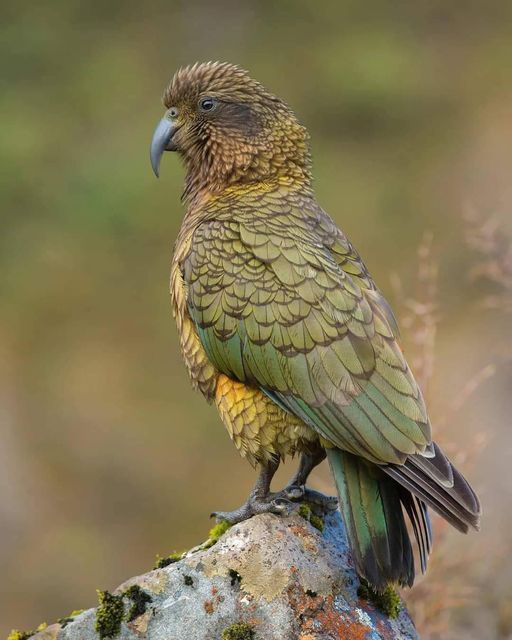
Kea (Nestor notabilis), family Strigopidae, found on the South Island of New Zealand
ENDANGERED.
A few ornithologists place this genus in its own family, Nestoridae, but this has not been widely adopted by ornithologists.
photograph by mikullashbee

Kereru or New Zealand Wood Pigeon (Hemiphaga novaeseelandiae), family Columbidae, Bay of Islands, New Zealand
photograph by Yi Feng

Tūī (Prosthemadera novaeseelandiae), family Meliphagidae, order Passeriformes, Waikawa, Marlborough, New Zealand
photograph by Sid Mosdell

Kakapo aka Owl Parrot (Strigops habroptila), family Strigopidae, order Psittaciformes, New Zealand
CRITICALLY ENDANGERED.
Photographs by the New Zealand Dept. of Conservation

Rifleman aka Titipounamu (Acanthisitta chloris), male, family Acanthisittidae, order Passeriformes, New Zealand
photograph by Mike Ashbee (@mikullashbee)

Okarito Kiwi (Apteryx rowi), chick, Apterygidae, order Apterygiformes, found in the Ōkārito forest on the West Coast of New Zealand’s South Island
VULNERABLE.
photographs by West Coast Wildlife Centre
533 notes
·
View notes
Text
The Kea
In the majestic Southern Alps of New Zealand, amidst rugged terrain and towering peaks, lives a bird that defies expectations and captures the imagination of all who encounter it. Meet the Kea (Nestor notabilis), a charismatic and highly intelligent parrot species endemic to the South Island of New Zealand. Revered for its remarkable intelligence, mischievous personality, and stunning plumage,…
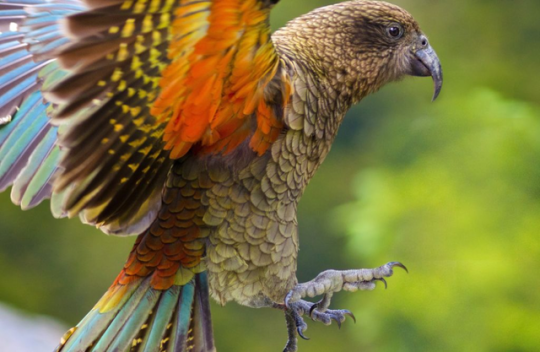
View On WordPress
0 notes
Text

[https://www.inaturalist.org/observations/156175996] Kea || Nestor notabilis Observed in New Zealand Endangered in location of observation
#ornithology#kea#birds#nature#wildlife#photography#air beast#earth beast#who cooks for queue? who cooks for queue all?
131 notes
·
View notes
